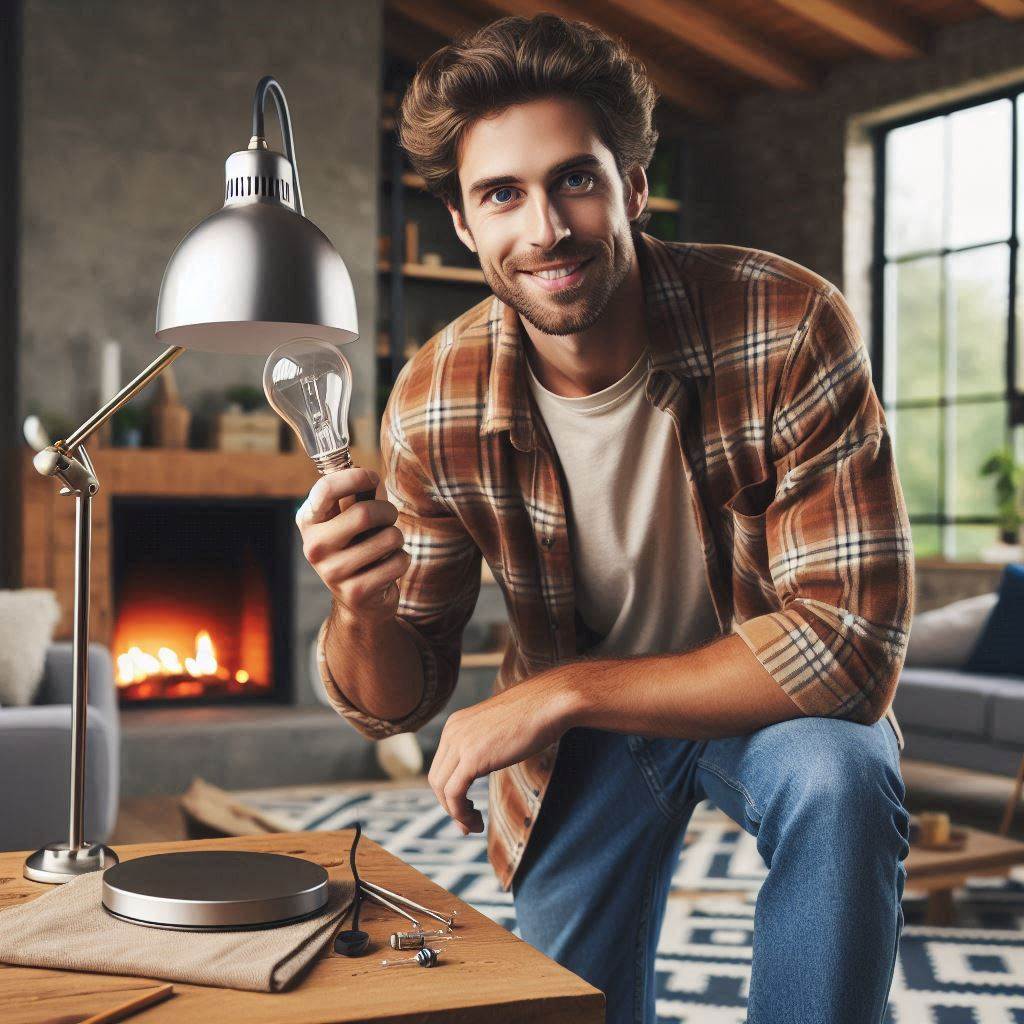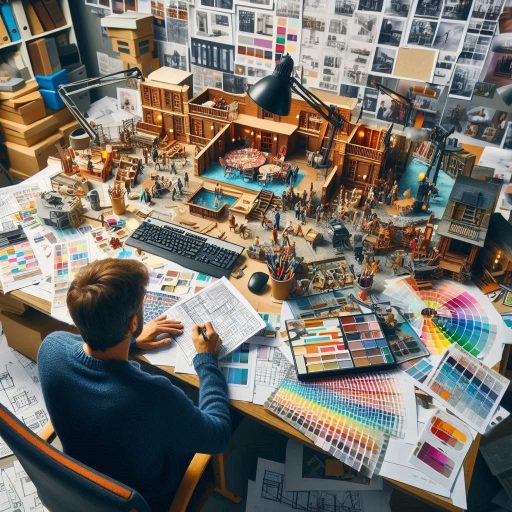Introduction
Marketing yourself as a lighting designer is essential for building a successful career.
It allows you to showcase your skills and attract clients.
In a competitive industry, effective marketing helps you stand out from the crowd.
Many talented designers compete for the same projects and clients, making visibility crucial.
A strong marketing strategy can set you apart and highlight your unique style.
Clients often look for designers who can deliver both creativity and reliability.
By effectively promoting yourself, you build trust and credibility in the market.
This blog post will cover several key points.
First, we will discuss building a professional online presence.
Your website and social media profiles should reflect your design philosophy and portfolio.
Second, we will explore the power of networking.
Connecting with industry professionals can lead to valuable referrals and collaborations.
Next, we will highlight the importance of showcasing your work.
Engaging visuals and case studies demonstrate your expertise and attract potential clients.
Finally, we will provide tips on leveraging online platforms and local events to enhance your visibility.
By implementing these strategies, you can effectively market yourself and grow your lighting design business.
Identify Your Unique Selling Proposition (USP)
What Sets You Apart from Other Lighting Designers
To market yourself effectively as a lighting designer, define what sets you apart.
Identify your unique value proposition.
What makes your services different from competitors? Consider your skills, experience, and perspective.
Do you specialize in residential, commercial, or event lighting? Perhaps you focus on sustainable or smart lighting solutions.
Understanding your niche helps you communicate your strengths.
For example, if you excel in eco-friendly designs, emphasize your commitment to sustainability.
If you have experience with high-profile projects, mention this expertise.
Highlight any certifications or unique training that enhance your credibility.
This differentiation will attract clients looking for specific expertise.
Use your unique qualities to create a compelling narrative about your design philosophy.
This narrative will form the backbone of your marketing strategy.
Showcase Your Strengths and Specialties
Once you identify what sets you apart, showcase your strengths and specialties.
Create an engaging online portfolio that highlights your best work.
Include high-quality images and detailed descriptions of each project.
Explain your design process and the impact of your work.
Consider creating case studies for significant projects.
Case studies allow potential clients to see your problem-solving skills.
They illustrate how you handle challenges and deliver results.
This approach builds credibility and demonstrates your expertise.
Utilize social media platforms to showcase your projects.
Share behind-the-scenes insights, design tips, and completed projects.
Regularly post engaging content to keep your audience informed and inspired.
Use hashtags related to lighting design to reach a broader audience.
Networking is also crucial.
Attend industry events and engage with other professionals.
Build relationships with architects, interior designers, and contractors.
These connections can lead to referrals and collaborations, expanding your reach.
Highlight Your Unique Style and Approach to Lighting Design
Highlighting your unique style and approach is essential in marketing yourself.
Every designer has a distinct aesthetic, and yours should shine through.
Consider what influences your designs.
Do you draw inspiration from nature, architecture, or art? Share your design philosophy with potential clients.
Create a consistent brand identity that reflects your style.
Use similar color schemes, fonts, and imagery across all marketing materials.
This consistency helps establish your brand and makes it recognizable.
Share your creative process through blogs or videos.
Explain how you develop concepts, select materials, and execute designs.
This transparency allows potential clients to connect with your artistic vision.
It also showcases your passion and dedication to lighting design.
Engage with your audience by asking for feedback on designs.
Use polls or questions on social media to involve them in your process.
This engagement builds a community around your brand and fosters loyalty.
Consider collaborating with influencers or complementary businesses.
Partnerships can expose you to new audiences and enhance your credibility.
Working with other professionals can also lead to innovative design ideas and projects.
Marketing yourself as a lighting designer requires a clear strategy.
Define what sets you apart and communicate this in your marketing efforts.
Showcase your strengths and specialties through a strong online presence.
Highlight your unique style and approach to create a lasting impression.
By following these steps, you’ll effectively market yourself and attract clients to your lighting design business.
Read: Top Skills Needed for a Successful Character Designer
Build a Strong Portfolio
Include High-Quality Images of Your Past Projects
Marketing yourself as a lighting designer begins with showcasing high-quality images of your past projects.
Visuals play a crucial role in attracting potential clients.
When clients can see your work, they gain confidence in your abilities.
Invest in professional photography to capture the essence of your designs.
Good lighting in photos highlights your creativity and technical skills.
Choose images that represent different styles and applications.
Include residential, commercial, and outdoor projects to appeal to diverse audiences.
Ensure your images are well-composed and accurately represent the lighting effects you created.
Consider using before-and-after shots to demonstrate the impact of your work.
Upload these images to your website and social media profiles.
A visually appealing portfolio catches the eye and encourages clients to reach out.
Consistently update your online presence with fresh content to keep potential clients engaged.
High-quality images serve as powerful marketing tools that showcase your expertise.
Showcase a Variety of Work to Demonstrate Versatility
Versatility is essential for any successful lighting designer.
Showcase a variety of work to appeal to different client needs and preferences.
Highlight projects across various sectors, including residential, commercial, and event lighting.
This variety demonstrates your ability to adapt to various styles and requirements.
For each project, provide a brief description.
Explain your design process, the challenges you faced, and how you overcame them.
This narrative helps clients understand your creative thinking and problem-solving skills.
Include images that represent different design styles, such as modern, traditional, or minimalist.
Consider featuring case studies that showcase your versatility.
Highlight specific projects where you used unique approaches to achieve desired effects.
This information helps potential clients envision what you can do for them.
The more diverse your portfolio, the more attractive you become to a wider audience.
Update Your Portfolio Regularly to Reflect Your Latest Work
Regularly updating your portfolio is crucial for staying relevant in the lighting design industry.
As you complete new projects, incorporate them into your portfolio.
This practice keeps your work fresh and showcases your growth as a designer.
Clients want to see your latest innovations and creative solutions.
Set a schedule for portfolio updates.
Consider refreshing your images and descriptions every few months.
This habit keeps your marketing materials current and engaging.
Highlight projects that demonstrate your latest skills or trends in lighting design.
Share your updated portfolio on various platforms.
Use your website, social media, and professional networks to reach a broader audience.
Announce your latest projects in blog posts or newsletters.
This proactive approach keeps your audience informed and interested in your work.
Building a Strong Personal Brand
Marketing yourself as a lighting designer involves more than just showcasing your work.
It requires building a strong personal brand.
High-quality images, diverse projects, and regular updates create a compelling narrative around your design philosophy.
As you develop your brand, focus on your unique selling points.
What sets you apart from other designers? Identify your strengths and use them to attract clients.
Engage with your audience on social media and through your website.
Respond to inquiries promptly and foster relationships with potential clients.
Networking is also crucial for promoting your work.
Attend industry events, trade shows, and local art exhibits.
Connect with other professionals in the field and build meaningful relationships.
These connections can lead to referrals and new opportunities.
By combining high-quality visuals, versatility, and regular updates, you can effectively market yourself as a lighting designer.
Show potential clients what you can do and how you can enhance their spaces.
Your dedication to showcasing your work will ultimately lead to a successful lighting design career.
Read: Career Paths in Ceramic Art and Design
Network with Industry Professionals
Attend Industry Events, Trade Shows, and Conferences
Attending industry events, trade shows, and conferences is essential for marketing yourself as a lighting designer.
These gatherings offer excellent networking opportunities.
They allow you to connect with potential clients and industry professionals.
Engage with others in your field and share your expertise.
Prepare to showcase your work at these events.
Bring a portfolio highlighting your best lighting designs.
Ensure your portfolio includes a variety of styles and projects.
This will demonstrate your versatility and attract diverse clients.
Participate in workshops and panel discussions.
These sessions can enhance your skills and provide valuable insights.
They also position you as an expert in your field.
Engage with speakers and attendees during these events.
Ask questions and share your knowledge to create lasting connections.
Collect business cards and contact information from new connections.
Follow up with personalized emails after the event.
This will help you maintain those relationships.
Consider attending these events regularly to stay current in the industry.
Building a reputation takes time and consistency.
Join Professional Organizations for Lighting Designers
Joining professional organizations is another effective way to market yourself.
These groups offer resources, support, and networking opportunities.
They can help you connect with other lighting designers and industry professionals.
Organizations often host events, webinars, and workshops that enhance your knowledge.
Membership in professional organizations adds credibility to your profile.
It shows potential clients that you are committed to your profession.
Many organizations also provide access to industry publications and resources.
Stay informed about trends, techniques, and innovations in lighting design.
Participate in organization activities actively.
Volunteer for committees or leadership positions to raise your profile.
This involvement can enhance your networking opportunities.
Attend meetings and engage in discussions to share your expertise.
Contributing to the community helps you establish your reputation as a knowledgeable professional.
Additionally, many organizations maintain online directories.
Being listed in these directories can lead potential clients to your services.
Update your profile regularly to reflect your latest projects and accomplishments.
This visibility can attract clients seeking experienced lighting designers.
Connect with Potential Clients and Collaborators Through Networking
Networking is vital for successfully marketing yourself as a lighting designer.
Build relationships with architects, interior designers, and builders.
These professionals often require lighting design services for their projects.
Attend local business events and community gatherings to meet potential collaborators.
Utilize social media platforms to expand your network.
Join groups or forums related to lighting design.
Engage in discussions and share your insights.
This can enhance your visibility and establish you as a thought leader in the field.
Host or participate in workshops and seminars.
This showcases your expertise while providing valuable information to potential clients.
When you share your knowledge, you build trust and credibility.
Consider offering free consultations or introductory services to attract new clients.
Leverage word-of-mouth marketing by asking satisfied clients for referrals.
Encourage them to share their experiences with others.
Positive reviews can significantly enhance your reputation.
Additionally, consider partnering with other professionals for joint marketing efforts.
Collaborative projects can expand your reach and introduce you to new clients.
Effectively marketing yourself as a lighting designer requires attending industry events, joining professional organizations, and networking.
By actively engaging in these activities, you can build connections, enhance your skills, and attract potential clients.
Consistent effort in these areas will help you establish a successful lighting design career.
Read: Freelance Character Design: How to Get Started

Utilize Social Media and Online Platforms
Create a Professional Website to Showcase Your Work
A professional website serves as your online portfolio and marketing tool.
Start by choosing a clean, modern design that reflects your brand.
Ensure that your website is user-friendly and easy to navigate.
Use high-quality images to showcase your lighting projects.
Include detailed descriptions for each project to highlight your design choices.
Incorporate a blog section to share insights about lighting design.
Regularly posting articles improves your website’s SEO, attracting more visitors.
Offer tips, trends, and case studies to establish your expertise.
Provide an “About” page that shares your story, qualifications, and design philosophy.
This personal touch helps potential clients connect with you.
Include a contact form so clients can easily reach you.
Clearly display your email address and phone number for additional accessibility.
Make sure to include links to your social media profiles on your website.
This encourages visitors to follow you and stay updated on your work.
Lastly, ensure your website is mobile-responsive.
Many potential clients browse on their phones.
A mobile-friendly site enhances user experience and keeps visitors engaged.
Regularly update your portfolio to reflect your latest projects and accomplishments.
This shows clients that you are active and committed to your craft.
Maintain Active Profiles on Social Media Platforms
Social media platforms like Instagram, LinkedIn, and Houzz are essential for marketing yourself.
Create and maintain active profiles to connect with potential clients.
Instagram is ideal for showcasing your visually appealing designs.
Post high-quality images and engaging captions to attract followers.
On LinkedIn, share your professional journey and network with industry peers.
Regularly update your profile with new projects, certifications, or collaborations.
This builds credibility and keeps your connections informed.
Houzz is another valuable platform for lighting designers.
It allows you to showcase your portfolio and connect with homeowners.
Encourage satisfied clients to leave reviews, as positive feedback enhances your reputation.
Engage with followers by responding to comments and messages promptly.
Building relationships fosters a sense of community and trust.
Follow other professionals in the lighting design and related industries.
This can lead to collaborations and valuable networking opportunities.
Engage with Followers and Share Updates About Your Projects
Engaging with your followers is crucial for building a loyal audience.
Share updates about your projects regularly to keep them informed.
Use Instagram Stories to provide behind-the-scenes glimpses of your design process.
This transparency creates a connection and invites followers into your world.
Host Q&A sessions on social media to address questions about lighting design.
Encourage followers to submit their queries in advance.
This interaction showcases your expertise and strengthens your relationship with your audience.
Additionally, consider hosting giveaways or contests to boost engagement.
Offer a free consultation or a discount on your services to generate excitement.
This encourages followers to share your profile, expanding your reach.
Utilize hashtags strategically to increase visibility.
Research relevant hashtags in the lighting and design industry.
Incorporate these hashtags in your posts to attract a wider audience.
In fact, marketing yourself as a lighting designer requires a professional website and active social media profiles.
Engage with your audience and share project updates to build a loyal following.
By implementing these strategies, you can effectively promote your brand and attract new clients.
Read: Career Paths: Becoming a Professional Character Designer
Collaborate with Other Design Professionals
Build Relationships with Architects, Interior Designers, and Contractors
Start by attending industry events, trade shows, and workshops.
These gatherings provide excellent opportunities to meet professionals in your field.
Engage with architects and interior designers to learn about their projects and needs.
Show genuine interest in their work and share your lighting design expertise.
Utilize social media platforms to connect with industry professionals.
Platforms like LinkedIn and Instagram allow you to showcase your work and engage with potential collaborators.
Share your projects, insights, and knowledge to establish yourself as an expert.
Regularly interact with your connections by commenting on their posts or sharing relevant content.
Join professional organizations and associations related to lighting design.
Membership in these groups helps you access resources, networking events, and educational opportunities.
Participate actively in meetings and discussions to demonstrate your commitment to the industry.
Additionally, reach out to local contractors and builders.
Introduce yourself and explain how your lighting designs can enhance their projects.
Offer to provide insights on lighting options during their project planning stages.
This proactive approach will help you gain their trust and establish long-lasting relationships.
Offer to Collaborate on Projects to Expand Your Network
Start by attending industry events, trade shows, and workshops.
These gatherings provide excellent opportunities to meet professionals in your field.
Engage with architects and interior designers to learn about their projects and needs.
Show genuine interest in their work and share your lighting design expertise.
Utilize social media platforms to connect with industry professionals.
Platforms like LinkedIn and Instagram allow you to showcase your work and engage with potential collaborators.
Share your projects, insights, and knowledge to establish yourself as an expert.
Regularly interact with your connections by commenting on their posts or sharing relevant content.
Join professional organizations and associations related to lighting design.
Membership in these groups helps you access resources, networking events, and educational opportunities.
Participate actively in meetings and discussions to demonstrate your commitment to the industry.
Additionally, reach out to local contractors and builders.
Introduce yourself and explain how your lighting designs can enhance their projects.
Offer to provide insights on lighting options during their project planning stages.
This proactive approach will help you gain their trust and establish long-lasting relationships.
Transform Your Career Today
Unlock a personalized career strategy that drives real results. Get tailored advice and a roadmap designed just for you.
Start NowWork Together to Create Cohesive and Innovative Designs
Successful collaborations lead to cohesive and innovative designs.
Work closely with your partners to ensure that lighting aligns with the overall vision.
Discuss color schemes, materials, and styles to create harmony in the project.
Be open to new ideas and perspectives during the design process.
Collaborating with other professionals often sparks creativity and leads to groundbreaking concepts.
Encourage brainstorming sessions where everyone shares their thoughts and inspirations.
Utilize technology to enhance collaboration.
Use design software to create shared digital spaces for brainstorming and feedback.
These tools streamline the design process and facilitate real-time collaboration, allowing for quicker decisions.
Once the project is complete, celebrate the success with your partners.
Share the project on social media, tagging everyone involved.
This visibility can attract more clients and lead to additional opportunities.
Marketing yourself as a lighting designer requires strategic networking and collaboration.
Building relationships with architects, interior designers, and contractors will enhance your visibility.
Offer to collaborate on projects to expand your network and showcase your unique expertise.
By working together, you create cohesive and innovative designs that attract new clients and elevate your career.
Offer Workshops and Training Sessions
Share Your Expertise Through Workshops and Training Sessions
One effective way to market yourself is by sharing your knowledge.
Offer workshops or training sessions on lighting design principles.
Target aspiring designers, homeowners, or industry professionals.
By educating others, you establish yourself as an authority in your field.
Promote your workshops on social media and your website.
Use engaging visuals to attract interest and showcase your skills.
Encourage participants to share their experiences online.
This generates word-of-mouth marketing that can draw more attendees in the future.
Consider partnering with local community centers or design schools.
This collaboration can help you reach a wider audience.
You can also offer online webinars to connect with participants beyond your local area.
Create informative materials, such as handouts or guides, for your attendees.
These resources reinforce your expertise and serve as marketing tools.
Attendees may share your materials with others, expanding your reach.
Position Yourself as an Industry Expert and Thought Leader
To stand out as a lighting designer, position yourself as an industry expert.
Start by creating valuable content related to lighting design.
Write blog posts, articles, or even a book sharing your insights.
Share case studies that demonstrate your successful projects.
Engage with your audience on social media platforms.
Share tips, trends, and updates about lighting design.
Respond to comments and questions to foster connections.
Engaging with your audience builds trust and positions you as an approachable expert.
Consider joining professional organizations in the lighting design field.
Membership offers networking opportunities and access to industry resources.
Participate in discussions, webinars, and panels to showcase your expertise.
Sharing your knowledge in these settings enhances your reputation.
Public speaking is another avenue to position yourself as a thought leader.
Speak at industry conferences, trade shows, or community events.
Sharing your insights with a larger audience boosts your visibility and credibility.
Gain Exposure and Credibility Within the Industry
Gaining exposure is essential for establishing your presence in the lighting design industry.
Collaborate with other professionals, such as architects or interior designers.
These partnerships can lead to referrals and joint projects.
Network actively at industry events, trade shows, and conferences.
Building relationships with peers can open doors for collaboration and referrals.
Don’t hesitate to follow up with contacts you meet.
A simple email can keep you on their radar.
Leverage social media platforms to showcase your work.
Share high-quality images of your projects and behind-the-scenes processes.
Use relevant hashtags to reach a broader audience.
Engaging content can attract potential clients and collaborators.
Consider getting featured in industry publications.
Submit articles or project highlights to magazines or blogs.
Being published enhances your credibility and exposes your work to a wider audience.
Online reviews and testimonials also play a crucial role in building credibility.
Encourage satisfied clients to leave positive reviews on platforms like Google or Yelp.
Highlight these testimonials on your website and social media profiles.
Marketing yourself as a lighting designer requires a multifaceted approach.
Share your expertise through workshops, position yourself as an industry expert, and gain exposure to build credibility.
By implementing these strategies, you can effectively promote your lighting design services and attract new clients.
Seek out Press Opportunities
Pitch Your Work to Design Publications, Websites, and Blogs
To market yourself effectively as a lighting designer, pitch your work to design publications, websites, and blogs.
Start by researching relevant platforms that showcase design projects and creative professionals.
Identify publications with a strong focus on interior design, architecture, or lighting design.
Craft a compelling pitch that highlights your expertise and recent projects.
Include a brief overview of your work, along with high-quality images.
Tailor each pitch to the specific publication or website, showing that you understand their audience and content style.
By getting your work featured in reputable design outlets, you gain credibility and visibility.
A well-placed feature can attract new clients and industry attention.
Consistently pitching your work will increase the chances of landing opportunities with multiple platforms.
Participate in Interviews and Guest Blogging Opportunities
Participating in interviews and guest blogging offers another way to market yourself.
Reach out to design websites, podcasts, and blogs that feature expert interviews.
Offer to share insights about your design process, industry trends, or lighting techniques.
Interviews help build your personal brand by positioning you as a thought leader in the lighting design industry.
Guest blogging allows you to showcase your expertise while providing valuable content to a broader audience.
Write blog posts that address lighting design challenges, offer tips, or highlight innovative trends.
Make sure the content is educational and aligns with the interests of the blog’s audience.
These platforms provide you with access to new readers and potential clients.
They also help strengthen your reputation as an expert.
By contributing regularly to design blogs and participating in interviews, you increase your visibility and build industry connections.
Showcase Your Expertise and Gain Exposure Through Press Coverage
Gaining press coverage is essential for boosting your profile as a lighting designer.
Reach out to media outlets that cover design, architecture, or home improvement topics.
Introduce yourself and share your latest projects, along with any unique approaches you bring to lighting design.
Press coverage not only showcases your work but also builds authority in your field.
Journalists and editors are always looking for fresh stories and expert opinions.
Position yourself as an expert who can provide valuable insights on lighting trends, smart lighting, or sustainable designs.
Collaborate with PR agencies if needed.
They can help you craft press releases and pitch your work to the right media contacts.
Keep your press materials professional, with high-quality photos and detailed descriptions of your projects.
Leverage any media coverage you receive.
Share articles, interviews, or features on your website and social media profiles.
Highlighting press mentions helps build trust with potential clients and demonstrates your credibility.
Marketing yourself as a lighting designer involves multiple strategies.
Pitch your work to design publications and blogs to gain exposure.
Participate in interviews and guest blogging to share your expertise.
Finally, pursue press coverage to build authority and reach a wider audience.
By actively engaging with these platforms, you’ll boost your visibility and strengthen your personal brand as a lighting designer.
Ask for Client Testimonials and Referrals
Encourage Satisfied Clients to Leave Reviews and Testimonials
Satisfied clients are one of your most valuable assets as a lighting designer.
Positive reviews and testimonials can significantly boost your reputation.
Make it a habit to ask clients for feedback after every project.
Express how much their opinions matter to your growth and the success of future projects.
Offer guidance on how to leave detailed reviews that highlight specific elements of your work.
Make it easy by sending them direct links to review platforms or your website.
Good reviews will strengthen your credibility and help potential clients make decisions confidently.
To get quality testimonials, follow up consistently.
You can encourage clients to reflect on how your lighting designs have enhanced their spaces.
Let them know that their experience can inspire others who seek similar transformations.
Positive testimonials provide proof of your abilities and expertise.
Include these testimonials prominently on your website, portfolio, and social media.
A great review builds trust and portrays you as a professional who delivers exceptional results.
Ask for Referrals from Past Clients and Industry Professionals
Referrals are a powerful way to grow your lighting design business.
Past clients and industry professionals who have worked with you are already familiar with your skills.
They can provide valuable word-of-mouth recommendations that bring new opportunities.
After completing a project, don’t hesitate to ask your satisfied clients if they know anyone who might benefit from your services.
Most happy clients are willing to refer you, but they may need a little nudge.
Be clear in your request and provide examples of the types of projects you seek.
You can also leverage your network of industry professionals.
Builders, architects, and interior designers are frequently in contact with potential clients who need lighting design services.
Maintain strong relationships with these industry peers.
When you consistently deliver high-quality work, they’ll be more likely to refer you to their clients.
Create a referral system that rewards those who refer you.
A simple thank you, a small gift, or even a referral fee can encourage future referrals.
Use Positive Feedback to Build Credibility and Attract New Clients
Positive feedback is one of the strongest tools you can use to build credibility.
Every time a client expresses satisfaction with your work, it becomes an opportunity to showcase your expertise.
Post positive reviews, testimonials, and client feedback on all your marketing channels.
A prospective client may need just one great review to convince them to hire you.
Sharing success stories highlights the value of your work and sets you apart from competitors.
You can also repurpose positive feedback for case studies or project spotlights.
These deeper dives into your past projects allow potential clients to see how your work impacts real spaces.
Displaying positive feedback on your website, social media, and email newsletters keeps your strengths front and center.
Prospective clients will be more likely to trust a designer who has a proven track record of happy clients.
By using positive feedback effectively, you create an ongoing cycle of credibility and trust.
This attracts more inquiries and keeps your business growing steadily.
Conclusion
Marketing yourself as a lighting designer is essential for success.
Start by creating a professional online presence.
Use a visually appealing website to showcase your portfolio.
Highlight your best projects and unique design style to attract potential clients.
Utilize social media platforms to reach a wider audience.
Share project updates, design tips, and behind-the-scenes content regularly.
Engaging with followers builds a loyal community and showcases your expertise.
Networking plays a significant role in gaining visibility.
Attend industry events, join design associations, and connect with other professionals.
Building relationships can lead to valuable referrals and collaborations.
Email marketing is another effective strategy.
Send newsletters featuring your latest projects, special offers, and design insights.
This keeps your brand in clients’ minds and encourages repeat business.
Consistency is crucial in all marketing efforts.
Regularly update your portfolio and social media content to maintain interest.
Implementing these strategies will help you stand out in a competitive industry.
Remember, effective marketing is an ongoing process.
Stay proactive and adaptable to changing trends.
By investing time in promoting yourself, you can attract more clients and establish a strong reputation.
Start today and watch your lighting design career flourish!
[E-Books for Sale]
The Big Book of 500 High-Paying Jobs in America: Unlock Your Earning Potential
$19.99 • 500 High-Paying Jobs • 330 pages
Explore 500 high-paying jobs in America and learn how to boost your career, earn more, and achieve success!
See All 500 High-Paying Jobs of this E-Book
1001 Professions Without a Degree: High-Paying American Jobs You Can Start Now
$19.99 • 1001 Professions Without a Degree • 174 pages
Discover 1001 high-paying jobs without a degree! Unlock career tips, skills, and success strategies for just $19.99!




